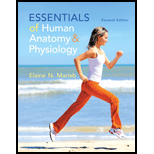
Essentials of Human Anatomy & Physiology (11th Edition)
11th Edition
ISBN: 9780321919007
Author: Elaine N. Marieb
Publisher: PEARSON
expand_more
expand_more
format_list_bulleted
Question
Chapter 8, Problem 43CAQ
Summary Introduction
Case summary:
Sonia dances and takes lessons so that she can improve her technique. While performing pirouettes she was advised to fix her gaze on a point. She fixes her gaze by turning her head quickly and allowed her body to rotate. This could lead to prevent her from getting dizziness.
Characters in the case:
Sonia, a dance coach.
Adequate information:
She fixed her gaze while doing pirouettes.
To determine:
Sonia does not get dizzy while doing pirouettes.
Expert Solution & Answer
Want to see the full answer?
Check out a sample textbook solution
Students have asked these similar questions
Please fill in all blank questions, Thank you
please fill in missing parts , thank you
please draw in the answers, thank you
Chapter 8 Solutions
Essentials of Human Anatomy & Physiology (11th Edition)
Ch. 8 - More than one choice may apply. Which of the...Ch. 8 - More than one choice may apply. Identify the...Ch. 8 - Prob. 3MCCh. 8 - Which cranial nerve controls contraction of the...Ch. 8 - The cornea is nourished by a. corneal blood...Ch. 8 - When the eye focuses for far vision, a. the lens...Ch. 8 - Convergence a. requires contraction of the medial...Ch. 8 - Prob. 8MCCh. 8 - Prob. 9MCCh. 8 - Prob. 10MC
Ch. 8 - Prob. 11SAECh. 8 - Prob. 12SAECh. 8 - 13. Diagram and label the internal structures of...Ch. 8 - Prob. 14SAECh. 8 - Prob. 15SAECh. 8 - 16. What is the blind spot, and why is it so...Ch. 8 - What name is given to the structure that controls...Ch. 8 - What is the fovea centralis, and why is it...Ch. 8 - Prob. 19SAECh. 8 - Describe the difference between the photopupillary...Ch. 8 - 21. Define hyperopia, myopia, and emmetropia.
Ch. 8 - Prob. 22SAECh. 8 - Prob. 23SAECh. 8 - Prob. 24SAECh. 8 - Many students struggling through mountains of...Ch. 8 - Prob. 26SAECh. 8 - Prob. 27SAECh. 8 - Prob. 28SAECh. 8 - Prob. 29SAECh. 8 - Prob. 30SAECh. 8 - Prob. 31SAECh. 8 - Prob. 32SAECh. 8 - Prob. 33SAECh. 8 - Which special sense requires the most learning?Ch. 8 - 35. For each of the following descriptions,...Ch. 8 - Prob. 36CAQCh. 8 - Prob. 37CAQCh. 8 - Prob. 38CAQCh. 8 - Brandon suffered a ruptured artery in his middle...Ch. 8 - Prob. 40CAQCh. 8 - Kathy visits her Optician as she has been...Ch. 8 - 42. Julie and her father love to find the...Ch. 8 - Prob. 43CAQCh. 8 - 44. Mrs. Garson has an immune disorder that causes...Ch. 8 - Prob. 45CAQ
Knowledge Booster
Similar questions
- a. On this first grid, assume that the DNA and RNA templates are read left to right. DNA DNA mRNA codon tRNA anticodon polypeptide _strand strand C с A T G A U G C A TRP b. Now do this AGAIN assuming that the DNA and RNA templates are read right to left. DNA DNA strand strand C mRNA codon tRNA anticodon polypeptide 0 A T G A U G с A TRParrow_forwardplease answer all question below with the following answer choice, thank you!arrow_forwardplease draw in the answeres, thank youarrow_forward
- A) What is being shown here?B) What is indicated by the RED arrow?C) What is indicated by the BLUE arrow?arrow_forwardPlease identify the curve shown below. What does this curve represent? Please identify A, B, C, D, and E (the orange oval). What is occurring in these regions?arrow_forwardPlease identify the test shown here. 1) What is the test? 2) What does the test indicate? How is it performed? What is CX? 3) Why might the test be performed in a clinical setting? GEN CZ CX CPZ PTZ CACarrow_forward
- Determine how much ATP would a cell produce when using fermentation of a 50 mM glucose solution?arrow_forwardDetermine how much ATP would a cell produce when using aerobic respiration of a 7 mM glucose solution?arrow_forwardDetermine how much ATP would a cell produce when using aerobic respiration to degrade one small protein molecule into 12 molecules of malic acid, how many ATP would that cell make? Malic acid is an intermediate in the Krebs cycle. Assume there is no other carbon source and no acetyl-CoA.arrow_forward
- Identify each of the major endocrine glandsarrow_forwardCome up with a few questions and answers for umbrella species, keystone species, redunant species, and aquatic keystone speciesarrow_forward19. On the diagram below a. Label the three pictures as: DNA; polypeptide; or RNA. b. Label the arrows as: translation or transcription/RNA processing. c. Add the following details to the diagram. Promoter region TATA box Transcription start site Transcription terminator Intron (A,B,C,D) Exons (1,2,3,4,5) Splice sites 5' cap 5' UTR (untranslated region) 3' poly A tail 3' UTR (untranslated region) Translational start (AUG) Translational stop (UGA, UAG, or UAA) N and C ends of polypeptide 0000arrow_forward
arrow_back_ios
SEE MORE QUESTIONS
arrow_forward_ios
Recommended textbooks for you
 Human Biology (MindTap Course List)BiologyISBN:9781305112100Author:Cecie Starr, Beverly McMillanPublisher:Cengage LearningSurgical Tech For Surgical Tech Pos CareHealth & NutritionISBN:9781337648868Author:AssociationPublisher:Cengage
Human Biology (MindTap Course List)BiologyISBN:9781305112100Author:Cecie Starr, Beverly McMillanPublisher:Cengage LearningSurgical Tech For Surgical Tech Pos CareHealth & NutritionISBN:9781337648868Author:AssociationPublisher:Cengage- Case Studies In Health Information ManagementBiologyISBN:9781337676908Author:SCHNERINGPublisher:Cengage
 Human Physiology: From Cells to Systems (MindTap ...BiologyISBN:9781285866932Author:Lauralee SherwoodPublisher:Cengage Learning
Human Physiology: From Cells to Systems (MindTap ...BiologyISBN:9781285866932Author:Lauralee SherwoodPublisher:Cengage Learning

Human Biology (MindTap Course List)
Biology
ISBN:9781305112100
Author:Cecie Starr, Beverly McMillan
Publisher:Cengage Learning


Surgical Tech For Surgical Tech Pos Care
Health & Nutrition
ISBN:9781337648868
Author:Association
Publisher:Cengage

Case Studies In Health Information Management
Biology
ISBN:9781337676908
Author:SCHNERING
Publisher:Cengage

Human Physiology: From Cells to Systems (MindTap ...
Biology
ISBN:9781285866932
Author:Lauralee Sherwood
Publisher:Cengage Learning
